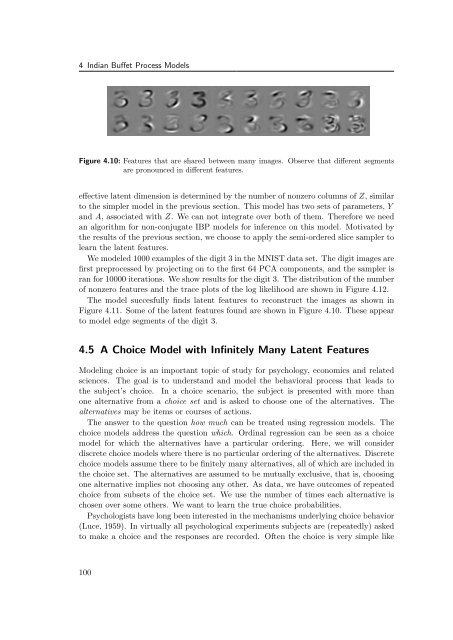Nonparametric Bayesian Discrete Latent Variable Models for ...
Nonparametric Bayesian Discrete Latent Variable Models for ...
Nonparametric Bayesian Discrete Latent Variable Models for ...
You also want an ePaper? Increase the reach of your titles
YUMPU automatically turns print PDFs into web optimized ePapers that Google loves.
4 Indian Buffet Process <strong>Models</strong><br />
Figure 4.10: Features that are shared between many images. Observe that different segments<br />
are pronounced in different features.<br />
effective latent dimension is determined by the number of nonzero columns of Z, similar<br />
to the simpler model in the previous section. This model has two sets of parameters, Y<br />
and A, associated with Z. We can not integrate over both of them. There<strong>for</strong>e we need<br />
an algorithm <strong>for</strong> non-conjugate IBP models <strong>for</strong> inference on this model. Motivated by<br />
the results of the previous section, we choose to apply the semi-ordered slice sampler to<br />
learn the latent features.<br />
We modeled 1000 examples of the digit 3 in the MNIST data set. The digit images are<br />
first preprocessed by projecting on to the first 64 PCA components, and the sampler is<br />
ran <strong>for</strong> 10000 iterations. We show results <strong>for</strong> the digit 3. The distribution of the number<br />
of nonzero features and the trace plots of the log likelihood are shown in Figure 4.12.<br />
The model succesfully finds latent features to reconstruct the images as shown in<br />
Figure 4.11. Some of the latent features found are shown in Figure 4.10. These appear<br />
to model edge segments of the digit 3.<br />
4.5 A Choice Model with Infinitely Many <strong>Latent</strong> Features<br />
Modeling choice is an important topic of study <strong>for</strong> psychology, economics and related<br />
sciences. The goal is to understand and model the behavioral process that leads to<br />
the subject’s choice. In a choice scenario, the subject is presented with more than<br />
one alternative from a choice set and is asked to choose one of the alternatives. The<br />
alternatives may be items or courses of actions.<br />
The answer to the question how much can be treated using regression models. The<br />
choice models address the question which. Ordinal regression can be seen as a choice<br />
model <strong>for</strong> which the alternatives have a particular ordering. Here, we will consider<br />
discrete choice models where there is no particular ordering of the alternatives. <strong>Discrete</strong><br />
choice models assume there to be finitely many alternatives, all of which are included in<br />
the choice set. The alternatives are assumed to be mutually exclusive, that is, choosing<br />
one alternative implies not choosing any other. As data, we have outcomes of repeated<br />
choice from subsets of the choice set. We use the number of times each alternative is<br />
chosen over some others. We want to learn the true choice probabilities.<br />
Psychologists have long been interested in the mechanisms underlying choice behavior<br />
(Luce, 1959). In virtually all psychological experiments subjects are (repeatedly) asked<br />
to make a choice and the responses are recorded. Often the choice is very simple like<br />
100
















